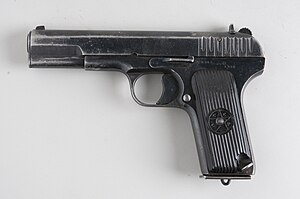D-70
| Type 70 pistol (D-70) | |
|---|---|
 An early-model D-70 of 1970s vintage. | |
| Type | Semi-automatic pistol |
| Place of origin | |
| Service history | |
| In service | 1970 to present |
| Used by | see "Users" |
| Production history | |
| Designer | Hwasŏng Arsenal 55 |
| Designed | 1966-1969 |
| Manufacturer | Yŏngjŏng 4th Machine Plant Daegok Arsenal |
| Produced | 1970-1995 |
| Specifications (D-70) | |
| Weight | 863 g |
| Length | 197 mm |
| Barrel length | 119 mm |
| Height | 135 mm |
| Cartridge | 7.5×25mm |
| Action | short recoil, tilting barrel, single-action |
| Muzzle velocity | 460 m/s |
| Effective firing range | 50 m |
| Feed system | 8-round detachable magazine |
| Sights | Front blade, rear notch |
The D-70 (Formal designation: 70식 단총 / 七〇式短銃, chillyŏng-sik danchong, "Type 70 pistol), also known as the Type 70 for its short designation, is a semi-automatic pistol designed in the Democratic People's Republic of Menghe. It was developed in the late 1960s as a replacement for the Type 26, which had been imported from Polvokia. Like the Type 26, it was chambered in the prewar 7.5×25mm cartridge, resulting in an effective but bulky weapon.
Development
During the Pan-Septentrion War, the standard infantry sidearm of the Greater Menghean Empire was the Type 26 pistol. This was a derivative of the Ostlandian Luger pistol, chambered in Menghe's 7.5×25mm cartridge. Following Menghe's defeat in 1945, production of the Type 26 continued in Polvokia, which had negotiated a licensing agreement during the war. Many of these Polvokian-produced weapons were smuggled back across the border during the Menghean War of Liberation, where they joined prewar-production Type 26s.
At the end of the War of Liberation, these pistols retained their Type 26 designation, and remained in service. While the weapon had a cherished reputation among senior officers for its wartime history, soldiers complained that the 40-year-old design was outdated, and in 1966 the refounded Hwasŏng Arsenal 55 began work on a replacement. This design, which drew heavily on the Letnian TT-33, retained the powerful 7.5×25mm cartridge but used a more conventional upper-slide configuration. The weapon was accepted for service in 1970, and received the designation Type 70; after 1990, the Menghean Army re-designated it D-70 in Anglian language sources, but continued to use the same Menghean-language designation.
Design details
The D-70 pistol uses Browning's short recoil, tilting-barrel operation, common on slide-type sidearms of the period. The trigger is single-action, requiring the user to manually cock the hammer before firing the first shot from a new magazine. The hammer and sear are borrowed directly from the TT-30, as this layout was found to be simpler and more reliable. A lever-type safety, absent on the TT-30, was added to the thumb position on either side of the slide.
The pistol fires the 7.5×25mm cartridge, which has a high muzzle velocity and a relatively flat trajectory. This gives it better accuracy at range than other 9mm cartridges, and more effective performance against body armor and light barriers. The magazine is single-stack, non-staggered, and carries 8 rounds. Sights consist of a blade-type foresight and a square aperture in the rear.
Reception
Despite the high performance of its cartridge, the D-70 pistol developed a poor reputation among the soldiers who used it. The long ammunition required a thick magazine, and consequently a thick pistol grip, resulting in poor ergonomics. The barrel, also long, required a large holster, and made the weapon a little clumsy to use, especially for officers trained on the Type 26.
Production quality on the first several batches of weapons was also very inconsistent, with poor tolerance levels and many weak components. These early pistols were prone to jamming, breakage, and safety failures, especially when exposed to rough usage in the field. After 1977, production was moved to a new factory with better machinery, but production at the old factory resumed between 1981 and 1986.
Lingering disappointment with the D-70 led the Menghean Army to issue a requirement for a new service sidearm in the late 1980s, resulting in the D-94.
Users
 Menghe: some reservist units.
Menghe: some reservist units.- Template:Country data Sundan: used by rebel forces and criminal organizations.
